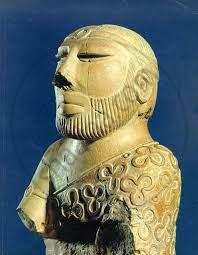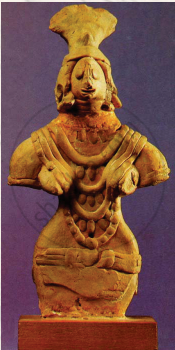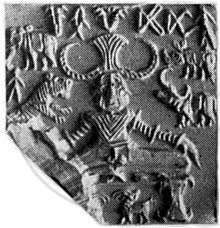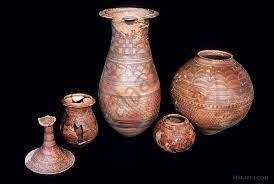Topics
Historiography : Development in the West
History : Applied History
Working of the Constitution
Historiography : Indian Tradition
The Electoral Process
Political Science : Working of the Indian Constitution
Applied History
Political Parties
History of Indian Arts
- What is ‘Art’?
- Indian Traditions of Visual Arts (Drik Kala): Painting
- Prehistoric Paintings
- Mural Paintings and Cave Painting
- Folk Styles of Paintings
- Classical Styles of Painting
- Miniature Paintings in Manuscripts
- Modern Indian Paintings
- Indian Traditions of Visual Arts (Drik Kala): Sculpture Art
- Indus Civilization Sculpture
- Folk Styles of Sculptural Art
- Classical Styles of Sculptural Art
- Indian Iconography
- Indian Traditions of Visual Arts (Drik Kala): Architecture and Sculpture
- Rock-cut Architecture
- Temple Architecture
- Indo-Islamic Architecture
- Indo-Gothic architecture
- Indian Traditions of Performing Arts
- Indian Theatre
- Indian Music
- Indian Dance
- Present Scenario of the Performing Arts
- Art, Applied Art, and Professional Opportunities
Social and Political Movements
- Movement
- Important Movements in India
- Tribal Movement
- Farmers Movement
- Worker's Movements
- Women’s Movement
- Environment Movements
- Consumer Movement
Mass Media and History
Challenges Faced by Indian Democracy
Entertainment and History
Sports and History
Tourism and History
Heritage Management
History - Imperialism
History - 20th Century Age of conflict
History - Emancipation of Asia and Africa
History - World after World War 2
Political Science
Geographical discoveries and colonization
- Concept for Geographical Discoveries and Colonization
Africa
- Imperialism - Africa
Asia: India, China, Japan
- Concept for Asia: India, China, Japan
Dictatorships in Europe, Second World War and world
- Concept on Dictatorships in Europe
- Concept for Second World War and World
First world war
- Concept on First World War
The League of Nations
- Concept for the League of Nations
Russian Revolution
- Concept for Russian Revolution
United Nations Organization
- Concept for United Nations Organization
Africa
- Emancipation of Africa
Asia
- Emancipation of Asia
Globalization
- Globalization After World War II
Scientific and Technological Progress
- Scientific and Technological Progress After World War II
Cold war
- Formation of the Cold War
Social Diversity and Democracy
- Social Diversity
- Coccept for Caste/Race and Democracy
- Concept for Language and Democracy
- Cocnept for Religion and Democracy
- Concept for Gender and Democracy
- Concept for Democracy and Diversity
Challenges to Democracy Remedial Measures to the Challenges
- Concept for Challenges to Democracy Remedial Measures to the Challenges
Internal work
Democracy
- Democracy - Meaning, Types and Characteristics
Political Parties and Types
- Political Parties
- Importance of Political Parties
- Major National and Regional Parties in India/ Types of Political Parties
Notes
Indus Civilization Sculpture
- During the second half of the third millennium BCE, the arts of the Indus Valley Civilisation emerged.
- Sculptures, seals, pottery, jewellery, terracotta figures, and other forms of art have been discovered at various sites throughout the civilisation.
- The artists of that period must have had fine artistic sensibilities and a vivid imagination. Because the anatomical details included in them were unique, their representation of human and animal figures was highly realistic in nature, and the modelling of animal figures in terracotta art was done with extreme care.
- While Harappa and Mohenjodaro are in Pakistan, important archaeological sites in India include Lothal and Dholavira in Gujarat, Rakhigarhi in Haryana, Ropar in Punjab, Kalibangan in Rajasthan, and others.
1. Bronze Casting
- The Harappans widely practised the art of bronze-casting.
- Kalibangan and Daimabad have yielded significant examples of metal-cast sculptures.
-
Dancing Girl: The earliest bronze sculpture dating to 2500 BCE is the 'Dancing Girl' from Mohenjodaro. This four-inch-high copper figure of a dancing girl is one of the most well-known Indus Valley artefacts. This exquisite casting, discovered in Mohenjodaro, depicts a girl with long hair tied in a bun. Her left arm is decorated with bangles, her right arm with a bracelet and an amulet or bangle, and her neck is adorned with a cowry shell necklace. Her right hand is on her hip, and her left hand is clasped in the manner of a traditional Indian dance gesture. Her eyes are large and her nose is flat. This figure is expressive and energetic, conveying a lot of information.
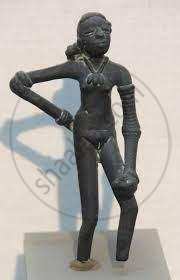
Dancing Girl
- Chariot: A similar group of bronze statuettes dating to 1500 BCE was discovered during an archaeological excavation in Daimabad, Maharashtra. The 'Chariot,' whose wheels are represented in simple circular shapes while the driver or human rider has been elongated, and the bulls in the forefront are modelled in sturdy forms, is significant.
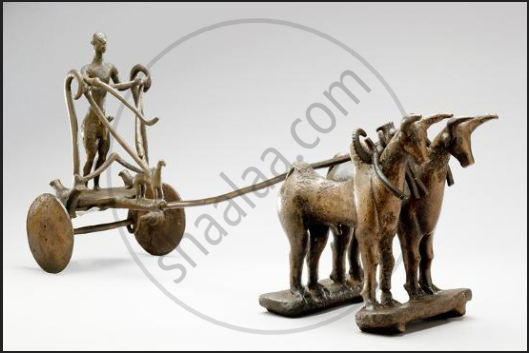
Chariot
- Bull: This bronze bull figure from Mohenjodaro is noteworthy. The massiveness of the bull and the fury of the charge are described in detail. The animal is depicted standing with his head to the right and a cord around his neck.

Bull
2. Bearded Priest:
|
Bearded Priest |
The bearded man, interpreted as a priest, is draped in a shawl that comes under his right arm and covers his left shoulder. This shawl features trefoil patterns. The eyes are slightly elongated and half-closed, as in meditation. The nose is medium in size and well-formed; the mouth is average in size with a close-cut moustache and a short beard and whiskers, and the ears resemble double shells with a hole in the middle. A plain woven fillet is wrapped around the head, and the hair is parted in the middle. On the right hand, an armlet is worn, and holes around the neck suggest a necklace.
3. Mother Goddess:
|
|
Mother goddess figures are typically crude-standing female figures wearing a loin cloth and a girdle and adorned with necklaces hanging over prominent breasts. The fan-shaped headdress with a cup-like projection on each side is a distinctive decorative feature of the Indus Valley mother goddess figures. The figures' pellet eyes and beaked noses are crude, and the mouth is indicated by a slit.
4. Pashupati seal/female deity:
|
Pashupati seal/female deity |
This seal features a cross-legged human figure. An elephant and a tiger are depicted on the right side of the seated figure, while a rhinoceros and a buffalo are depicted on the left. In addition to these animals, two antelopes are depicted beneath the seat. Seals like these were discovered in large numbers at sites like the ancient city of Mohenjodaro in the Indus Valley between 2500 and 1900 BCE.
5. Pottery:
|
Pottery |
The majority of Indus Valley pottery is made on a wheel, with only a few exceptions being handmade. Plain pottery is more common than painted ware. Polychrome pottery is uncommon and consists primarily of small vases decorated with geometric patterns in red, black, and green, with a few examples in white and yellow.
